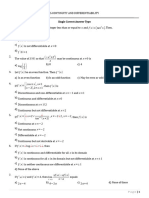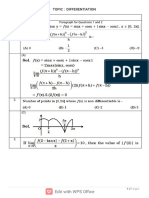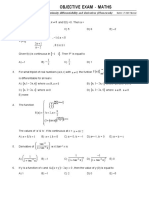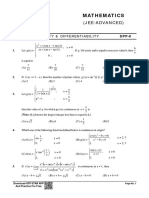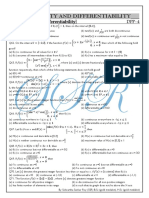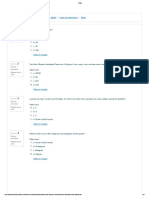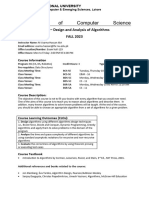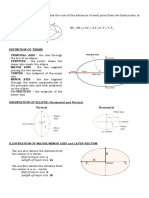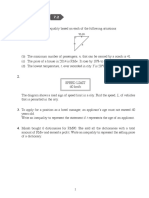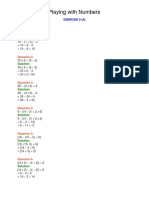Sri Chaitanya IIT Academy, A.P.
,
Sri Bhaskar Bhavan, Vijayawada
Sec : Sr.IPL-IC Date : 31-10-
13
CONTINUITY AND DIFFERENTIABILITY
Single answer type questions:
1. If x R + and n N, we can uniquely write x = mn + r where m W
and 0 r < n. We define x mod n = r. For example 10.3 mod 3 =
1.3. The number of points of discontinuity of the function
f(x) = (x mod 2) 2 + (x mod 4) in the interval 0 < x < 9 is
(A) 0 (B) 2 (C) 4 (D) None of these
2. Domain of derivative of the function is
(A) (B) (C) (D) R
3. If then at
(A) is continuous and differentiable
(B) is continuous but not differentiable
(C) not continuous but differentiable
(D) is neither continuous nor differentiable
4. If then the curve is
(A) continuous every where except at
(B) differentiable every where except at
(C) continuous every where except at x =
(D) differentiable every where
5. If has exactly four points of discontinuity for
then
(A) Minimum value of n is 5
(B) Maximum value of n is 6
(C) There are exactly two possible values of n
(D) There are exactly only one value of n
6. Let f be a differentiable function such that and
g(x) = f(1 + x) then
Page No 1
� a) g(x) is neither even nor an odd function b) g(x) is an odd function
c) d) graph of f(x) is symmetrical w.r.t the line x = 1
7. If and , then g (x) is
a) Continuous in R - {0,3} b) Continuous in R
c) Differentiable in R - {0, 1, 2} d) Differentiable in R - {1, 2}
8. . The point M on line y= x for which perimeter of is least is
(A) (0, 0) (B)
(C) (D) can not be found
9. If a function is defined on and then
(A) no such that if and only if is continuous
(B) a function differentiable on satisfying the given
hypothesis
(C) If satisfying the given hypothesis then must be
discontinuous
(D) None of these
10. If is a polynomial satisfying the relation then
is equal to
(A) 1
(B) 3
(C) cannot be found since degree of is not given
(D) 2
11. Let
are real numbers and
for then is
(A) 1 (B) (C) (D)
12. If and that is differentiable at x = 0, and ‘k’ is a positive integer.
Then
(A) (B) (C) (D) does not exist
Page No 2
�13. If every root of a polynomial equation (of degree ‘n’) with leading
coefficient “1” is real and distinct, then the equation
has.
(A) at least one real root (B) no real root
(C) at most one real root (D) exactly two real roots
14. If and , where ‘c’ is a constant then
(A) (B) (C) (D) none of these
15. A function satisfies the equation
.If f is differentiable on and , then _____
(A) (B) (C) (D)
16. If and then is discontinuous at
(A) exactly one point (B)exactly two points
(C) exactly three points (D) no point.
17. If , then number of points at which the function is
discontinuous is , ( [ . ] denotes greatest integer function )
(A) 12 (B) 13
(C) 14 (D) 7
18. If a function is an odd function such that for
and the left hand derivative at x=a is zero then left hand derivative
at is____
a) a b) 0 c) –a d) 1
19. Let ,then f(x) is continuous but not differentiable at x =
0 if
a) n (0,1] b) n [1, ) c) n (– ,0) d) n = 0
20. If is continuous on [-2,5] and differentiable over (-2,5) and -4
for all x in (-2,5) then the greatest possible value of is
a) 7 b) 9 c) 15 d) 21
Page No 3
�21. Let be a function such then
a) is a quadratic function b) is continuous but not differentiable
c) is differentiable in ‘R’ d) is bounded in R
22. If where [.] denotes the greatest integer function, then
the set if points of discontinuity of in its domain is
a) Z b) Z\{0, -1}, c) R\[-1, 0) d) R+
23. The jump of the function at the point of discontinuity i.e., x = 1 of the
function
is
a) b) c) d)
24. Let where [x] denotes the greatest integer function. Then
a) is continuous on R+ b) is continuous on R
c) is continuous on R ~ I d) is continuous on (R – I) {0}
25. Let
([.] denotes the greatest integer unction) if f(x) is continuous at x = 2, then
a) a = 1, b = 2 b) a = 1, b = 1 c) a = 0, b = 1 d) a = 2, b = 1
26. If f(x + y) = f(x) + f(y) + 2xy - 6 for all x, yÎR and f ¢(0) = 2, then y = f(x) will be
(A) straight line (B) parabola
(C) ellipse (D) circle
27. Let I(l) = (lÎR, l > 1) then I(l) lie in
(A) (1, ¥) (B) (0, l)
(C) (D) none of these
28. Consider the function where P(x) is a polynomial such that
is identically equal to 0 and If f(x) is continuous at x = 2, then p(x)
is
(A) (B)
Page No 4
� (C) (D)
29. If [.] denotes the integral part of x and , then
(A) f(x) is continuous in R
(B) f(X) is continuous but not differentiable in R
(C ) f’(x) exists
(D) is discontinuous at all integral points in R
30. Let for real x and y. If (0) exists and equals to -1
and f(0)=1 then the value of f(2) is
a) 1 b) -1 c) d) 2
One or more than one answer type questions:
1. If , where denotes the greatest integer
function, then
a ) f x is continuous in 0, b) f x is not continuous at x = 0
2
c ) f x is continuous at x = 0, d ) f x has infinite points of discontinuity
4
2. Which is discontinuous at
(A) (B)
(C) and (D) and
3. If and then
(A) is discontinuous every where (B) is discontinuous every where
(C) is continuous every where (D) Range of is a single ton set
4. , where denotes greatest integer function. Then f is
a) continuous at b) continuous in
c) differentiable in d) differentiable at
5. Let be a non constant polynomial satisfying the relation
for all real x and y and , suppose
. Then
(A) is a polynomial of degree 2 (B) roots of are real
Page No 5
� (C) (D)
6. If where then
.
(A) is an even function (B) is an odd function
(C) (D)
7. Consider the function defined in as
. Then
(A) has right derivate at (B) is discontinuous at
(C) is continuous at (D) is differentiable at
8. If maximum Then the total number of points where
is not-differentiable at
(A) (B) (C) Two irrational points (D) none
9. Let a function satisfies the equation ,
then
(A) f is continuous for all if it is continuous at x = 0
(B) , if ‘f’ is continuous
(C) is not a periodic function (D) is differentiable for all
10. A function satisfies the equation for all x, y in R
and for any . Let the function be differentiable at x = 0 and
then.
(A) (B)
(C) is every where continuous (D) is an Irrational
number
11. Let and and then
(A) is continuous (B) is differentiable
(C) is both continuous and differentiable
(D) is discontinuous at x = 0
12. If in here [.] denotes the greatest integer then
is.
Page No 6
� (A) discontinuous at x = 0 (B)continuous at x = 0
(C) discontinuous at x = 1 (D) not differentiable at x = 0
13.
(A) is discontinuous at x = 2 (B) is continuous but not
differentiable at x =2
(C) is differentiable every where
(D) The right derivative of at x =2 does not exist
14. If then
(A)
(B)
(C)
(D) is continuous and differentiable for all real values of x.
15. If then
(A) is continuous at all points in its domain
(B) is differentiable at all points in its domain.
(C) for all (D) Range of function is
Comprehensions type questions:
Passage - 1
To evaluate , we must analyze f(x) in a right hand neighborhood as
well as in left hand neighborhood of x = a. For example in case of
continuous function we may come across following cases
Case – 1 : Case – 2 :
Case – 3: Case 4:
If f(a) is an integer, the limit will exist in case of case – 3 and case – 4 but
not in case – 1 and case – 2
if f(a) is not an integer, the limit will exist in all the cases.
Page No 7
� Similar analysis may be required for Discontinuous functions at x = a
1. If does not exist, (where [.] denotes the greatest
integer function), then
a) f(1) may be integer b) ({.} fractional part of x)
c) f(1) is not an integer d) none of these
2. (where [.] denotes the greatest integer function)
a) 0 b) 1 c) – 1 d) doesn’t exist
3. is equal to (where [.] denotes the greatest integer function)
a) 0 b) 1 c) -1 d) doesn’t exist
Passage - 2
Let be a polynomial with positive leading coefficient and ; and
Then
4. Degree of the polynomial is_____
(A) 4 (B) 3 (C) 5 (D) 2
5. is discontinuous at x =
(A) 0 (B) 1 (C) -1 (D) none of these
6. If and is inverse of _______
(A) is equal to (B) is equal to (C) is equal to 8 (D) does not exist.
Passage - 3
Let be a continuous function for such that and
(1) The graph of is made of line segments joined such that left end
point is included and right end point is excluded in each sub interval
(2) The graph starts at the point .
(3) The derivatives of , where defined, agrees with the step pattern as
shown here.
Page No 8
� Using the above information answer the following.
7. The range of is _____
(A) (B) (C) (4)
8. Number of integral roots of the equation is
(A) exactly 3 (B) exactly 4 (C) exactly 2 (D) none
9. The set of points of discontinuities of in its domain are
(A) (B) (C) (D) none
Passage - 4
For let
Answer the following questions.
10. is equal to
(A) 0 (B) (C) (D) does not exist
11. at _______
(A) continuous
(B) discontinuous
(C) both continuous and differentiable
(D) continuous but not differentiable.
12. In , the number of points at which vanishes is
(A) 0 (B) 1 (C) 2 (D) 3
Matching answer type questions:
1. Column – I Column – II
(A) The function (P)
Is differentiable then
Page No 9
� (B) The function (Q) b = 5
Is differentiable every where
(C) The function (R)
Is differentiable every where then
(D) If (S) b = 3/2
is continuous at x = 0 then ([.] denotes the greatest integer (T)
2. Now match column – I to column – II
Column – I Column – II
(a) is (p) continuous at x =0
(b) is (q) discontinuous at x =0
(c) is (r) differentiable at
(d) is (s) non – differentiable at
(t)discontinuous and not differentiable at x=0
Integer answers type questions:
1. If where f ’’(x) = –f(x) and and given that
F(5) = 5, then F(10) is equal to
2. The function given by the value of for which the function
f(x) is continuous at from the right, must be ____________
3. Over the interval the function is discontinuous at K points then K
must be equal to __________
4. The number of two digits numbers ‘a’ whose sum of digits is 9 such that
Page No 10
� is continuous in is.
Here denotes the greatest integer function
5. If then the number of points of discontinuity of the function
(fof) (x) in [0, 3] is
6. The number of points at which is not differentiable is
where [ . ] denotes G.I.F
7. Number of points of discontinuity of the function
is
8. If the function and then the value of is.
9. If , then
10. Let and be twice differentiable functions satisfying
and then the value of
is equal to
11. Let be a real function not identically zero such that
and x, y are any real numbers and , then the value of is.
12. Let be a function such that . If . Then
the value of where is.
13. Let ‘f’ is a differentiable function such that then the
value of where [.] denotes the greatest integer is.
14. If ‘f’ is a polynomial function satisfying the condition
and then the value of is.
15. If then the number of points where the function
is not differentiable is.
16. Number of point (s) of discontinuity of the function where [ . ]
represents G.I.F is
Page No 11
� CONTINUITY AND DIFFERENTIABILITY – KEY SHEET
Single Answers
1 C 2 B 3 D 4 B 5 C 6 D
7 A OR C 8 A 9 B 10 D 11 B 12 B
13 B 14 C 15 D 16 C 17 B 18 B
19 A 20 D 21 B 22 B 23 B,D 24 B
25 B 26 B 27 C 28 B 29 D 30 B
One or more than one Answers
1 AC 2 BCD 3 ABCD 4 ABC 5 ABCD 6 AB
7 AB 8 ABC 9 ABCD 10 ABCD 11 ABC 12 BCD
13 AD 14 ABCD 15 ACD
Comprehensions Answers
1 C 2 C 3 B 4 D 5 A 6 B
7 C 8 C 9 A 10 C 11 B 12 A
Matching Answers
1 A-PQ 2 A-QST
B-ST B-PS
C-R C-PR
D-P D-QST
Integer Answers
1 5 2 2 3 5 4 9 5 2 6 4
7 9 8 7 9 8 10 5 11 5 12 0
13 5 14 2 15 5 16 1
MEAN VALUE THEOREMS, ROLLS THEOREM
Single answer type questions:
1. Rolle’s theorem holds in [1, 2] for the function at the
Point . The values of b, c are respectively
(A) (B) (C) (D)
2. If a, b, c are positive numbers such that a>b>c and the equation
has a root in the interval then
A) b cannot be the G.M. of a, c B) b may be the G.M. of a, c
C) b is the G.M. of a, c D) none of these
3. If the function satisfies conditions of Rolle’s theorem in [1, 3]
and then value of a and b are respectively
(A) 1, –6 (B) –1, 6 (C) –2, 1 (D) –1, 1/2
Page No 12
�4. Let Where
and exists at all points in . Then, there exists a real number
such that
a) b) c) d)
One or more than one answer type questions:
1. Let and be twice differentiable functions on R and
, then
a) b)
c) for at least one d) for at least one
2. If a, b, c are +ve integers such that a>b>c and quadratic equation
(a + b-2c) + has a root in then
(a) (b)
(c) both roots of the given equation are rational
(d) the equation has both negative real roots
Comprehensions type questions:
Passage – 1:
If the function f(x) is continuous and has continuous derivatives through order n-1
on the interval and has a finite derivative of the nth order at every interior
point of the interval. Then, at ,
where
is called TAYLOR’S FORMULA of the function f (x).
Put a = 0, we obtain MACLAURIN’S FORMULA!. The last term in both TAYLOR AND
MACLAURINE formulae are called REMAINDER ANSWER THE FOLLOWING
01. The polynomial can be expressed in powers of
as,
a) b)
c) d)
02. In the expansion of on the remainder in maclaurin’s
form, is given by
a) b) c) d)
Single Answers
1 B 2 A 3 A 4 C
Page No 13
�One or more than one Answers Comprehensions Answers
1 D 2 BCD 1 A 2 A
Page No 14





